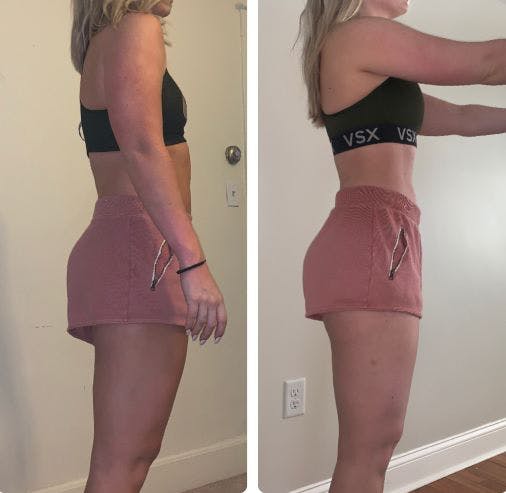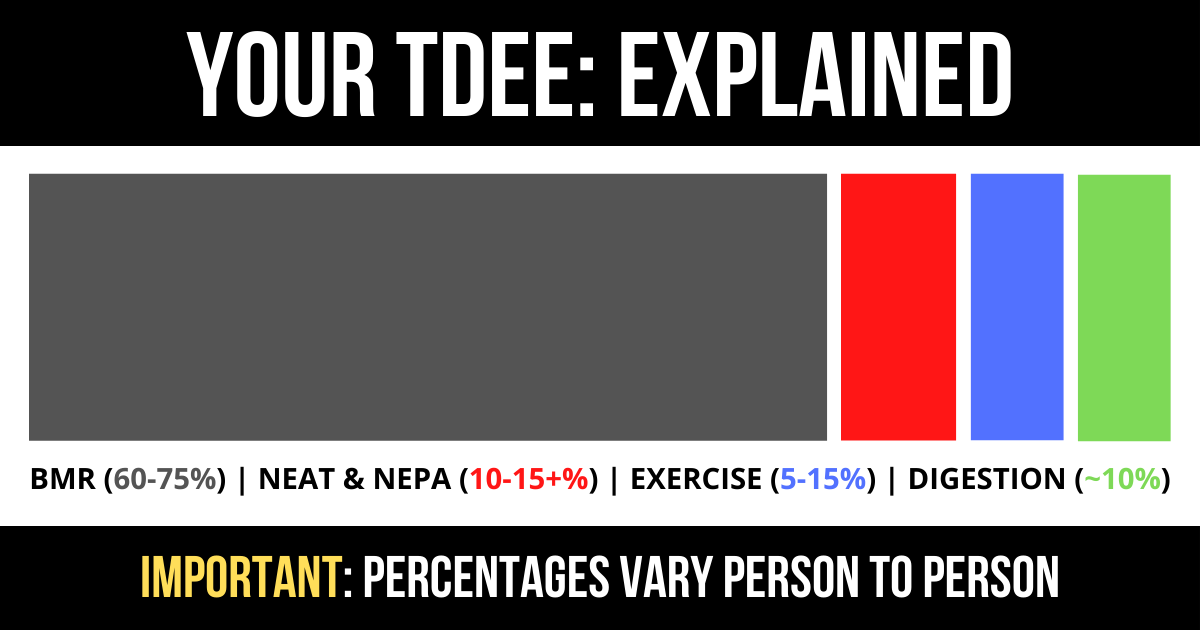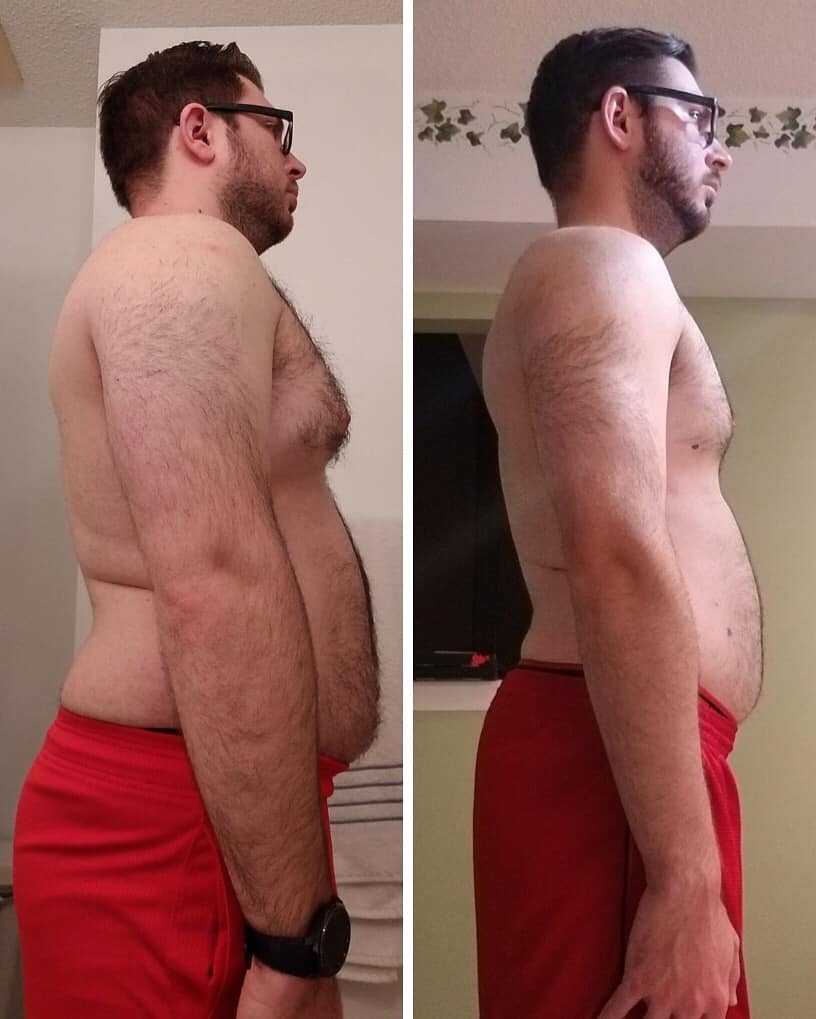I won’t beat around the bush here.
There’s a good chance your “plateau” isn’t an actual plateau: where weight loss inexplicably stalls. There’s a much better chance you’re:
- Being extremely impatient
- Not measuring your progress well
- Eating more than you think
Only after we avoid these does a “mistaken” plateau become a real plateau. Allow me to explain why:
1) 3-14 days at roughly the same weight is normal
Even if you’re eating “perfectly.” So if you’re panicking because this Friday’s weigh-in was the same as last Friday’s… you have a patience issue. Not a plateauing issue.
I don’t even consider adjusting a client’s plan until the scale hasn’t budged for 14+ days. And even then — reducing their calories is a last resort (more on this soon).
2) The scale doesn’t tell the full story
I can’t even tell you how many times I’ve seen someone’s weight “stall” — only to see huge changes in their photos and measurements days later. My longtime client Jen experienced this impressive transformation without much scale change:

I’m not saying to do nothing if the scale isn’t budging for weeks on end. Only to get “all the data” before making a decision.
3) It’s ridiculously easy to “accidentally” overeat
I know you’re convinced you’ve been eating 1,000-1,200 calories for the last several weeks. But there’s an infinitely better chance you’re eating more than you think. Which is the real cause of your “plateau” 110% 90+% of the time.
Addressing this issue tends to produce results in as little as 3-7 days (no calorie cuts required).
I’m sure you’ve noticed a theme by now:
Cutting your calories is an absolute last resort when the scale isn’t budging.
There are four better ways to handle frustrating weight loss plateaus — and I’m going to show you all four (in order):
Step #1: Assess your patience levels
You should never step on the scale with an expectation of any kind. I don’t care how well you ate the day before. I don’t care if you ate a bunch of salads last week. I don’t even care if you fasted for 24 hours before weighing in.
The scale doesn’t measure short-term fat loss and one-off weigh-ins are completely useless. Even 3-7 days of weigh-ins are pretty useless. The readings are affected by anything from your:
- Workouts
- Gut content
- Sodium intake
- Menstrual cycle
- Hydration levels
- Bowel movements
- Scale quality
The list goes on.
There’s simply nothing for us to look at until we have 2+ weeks of averages to work with. You’re being ridiculously impatient if you’re frustrated with a “lack of progress” sooner than this.
And remember: losing half a pound or a pound per week is perfectly solid. This is anywhere from 25-50+ pounds per year: a substantial change in a measly 1.3% of your lifetime.
Step #2: Take updated photos and measurements
The scale measures weight loss — not fat loss. This distinction matters. Because it’s possible to lose fat without losing weight.
My longtime client Jen (whose photo you saw above) is the perfect example. She experienced what’s called a “recomposition”: where you lose fat while building muscle. This results in massive visual differences — but little to no change on the scale.
Recompositions are most realistic for:
- Anybody losing a large percentage of their bodyweight
- Anybody new to strength training and eating enough protein
- Anybody taking steroids
That’s why it’s so important to track your progress in several different ways. You might be making great progress over a 3-4 week stretch… but won’t have any clue if you’re only using a scale.
Here’s the best way to take progress photos:
And measurements:
Step #3: Assess your tracking accuracy
If your bodyweight averages haven’t budged for 2+ weeks and there are no changes in your updated photos and measurements… it’s time to assess your tracking accuracy. Because there’s a damn good chance you’re eating more than you think. The most common culprits are:
- Meals out
- Liquid calories (everything from coffee creamer to alcohol)
- Snacking
- Little bites and sips
- Eyeballing your portions (instead of weighing them)
- Untracked splurges
I actually listed 20+ sources of missing calories in a separate article — but these six alone are problematic enough for most people.
The good news is… there’s an easy fix: clean up your tracking issues for 7-10 days and see if the scale budges. It’s exceptionally rare for it not to if you’re:
- Eating most of your meals at home
- Owning every decision — even the not-so-healthy stuff
- Using a food scale (measuring cups and spoons aren’t great)
But there’s a catch: you can’t take your foot off the gas when you start seeing progress again. That’s like no longer checking price tags as soon as you’re out of debt. Or no longer doing your physical therapy drills the second you’re in less pain.
You have to keep up with the habits that brought you success in the first place.
Step #4: See what you can add more of
Can you tell I’m incredibly resistant to taking food off someone’s plate?
You won’t see this next step in most resources on overcoming plateaus — but it’s a hugely important one.
If your:
- Bodyweight averages haven’t budged for 2+ weeks
- Updated photos and measurements don’t show any change
- Tracking accuracy has been rock solid for 7-10+ days
Then we can adjust your plan. But not necessarily in the form of cutting calories. It’s important for us to understand our “TDEE” (total daily energy expenditure) first. Here’s how you burn calories on a daily basis:
- Your basal metabolic rate (BMR): the calories you burn at total rest while performing basic functions (like breathing and pumping blood). This accounts for 60-75% of calories burned on a daily basis
- Non-exercise activity (NEAT and NEPA): the number of calories you burn while walking or fidgeting. This accounts for 10-15+% of calories burned on a daily basis
- Your workouts (EAT): the number of calories you burn while exercising. This accounts for 5-15% of calories burned on a daily basis
- The thermic effect of food (TEF): the number of calories you burn digesting your food. This accounts for ~10% of calories burned on a daily basis
Here’s a helpful visual:

By boosting one or more of these areas… you probably won’t need to cut your calories to see more progress. Here are the best ways to do it:
- Take your sleep hygiene ridiculously seriously (the single most underrated fat loss tip and it’s not even close)
- Make every effort to manage your stress (another highly underrated strategy)
- Bump your step goal. 6,000-8,000 steps per day is a good starting spot for most people. But 10,000+ steps per day has tremendous upside if you can get there
- Focus on building muscle. You’re leaving a lot of results on the table if you’re only doing group exercise classes and cardio. Muscle is more “metabolically active” than fat — meaning people with more of it burn more calories at rest
- Eat more protein. .8+ grams per day is the minimum target for most of my clients. But ~1 gram per pound of bodyweight is a good spot to be in if you struggle with cravings. It even burns more calories during digestion (via the “thermic effect of food”)
You can request a complimentary copy of the One-Stop Nutrition Guide — my single best guide on boosting your intake — if this is an area you struggle with:

Just tell me where to send your copy:
Step #5: Reduce your calorie range
In the rare scenario you've been:
- Very patient with your progress
- Consistently measuring your progress in 3+ ways
- Tracking your food and drink intake very accurately
- Making every effort to boost your TDEE
And still haven't seen progress for 2-3 weeks... fine. We can discuss cutting your calories. But it should go without saying that I'm assuming you had a sensible calorie target to begin with. Every step I've listed is a little moot if you got set up with an unreasonably high range.
You'll notice I say "range" because I'm not a fan of strict calorie targets. I typically give my clients a 100-200 calorie buffer (ex. 1,950-2,100 calories per day instead of 2,025 on the dot) to allow for flexibility and intuitiveness.
The exact amount we'll drop the range varies person to person. But 250-350 calories per day tends to be the sweet spot for producing more progress (unless their range is already on the lower side).
BONUS: Don't adjust anything else for 14+ days
This article wouldn't be complete without one more reminder to STOP cutting your calories so damn much. If you made it all the way to Step #5 and dropped your range... don't touch it again for 14+ days.
Progress isn't linear and it certainly isn't overnight. Let your body adjust to this new range and repeat Steps #1-4 while you do. You can only cut your calories so much before "damaging" your body or relationship with food.
And it's worth repeating: I've never had a client diligently follow Steps #1-4 and not see results.
There is one last unique scenario worth discussing:
"What if I've followed Steps #1-4 to a T? But I can't reasonably follow Step #5 and reduce my calories any further?"
This comes up from time to time with petite women or chronic dieters. They're doing absolutely everything correctly... but they're down to 1,350-1,450 calories per day and shouldn't go any lower.
The solution here isn't remotely appealing to people who want to lose more fat... but taking several months off from dieting is a no-brainer. This is the only way to meaningfully boost your TDEE and reverse the metabolic adaptations you may be experiencing.
I wrote an entire article on long-term maintenance phases here.

Eric is a great example of a client who willingly took breaks from dieting... and reaped the rewards
Let's recap the five best ways to handle a frustrating weight loss plateau:
- Step #1: Assess your patience levels
- Step #2: Take updated photos and measurements
- Step #3: Assess your tracking accuracy
- Step #4: See what you can add more of
- Step #5: Reduce your calorie range
If the off chance you get to Step #5: don't touch your range again for 14+ days. There's absolutely no reason to if you're interested in no longer yo-yo dieting -- which is my own biggest priority for all my VIP coaching clients.
I actually created a new video course on the subject (breaking out of the yo-yo cycle) right here:
It's totally free to join and breaks down the four biggest mistakes yo-yo dieters make... all of which keep us in vicious dieting cycles for years on end.





